by benjamin bannister
Why Typography Matters — Especially At The Oscars

There was a major twist ending and a major snafu at the very end of the 2017 Academy Awards for the category of Best Picture. The wrong winner was declared. If you look back on the footage and analyze it, you could read on Warren Beatty’s face that something was not right just before the Best Picture winner was announced.
Let’s quickly review the second-by-second timeline of what happened:
- Warren Beatty and Faye Dunaway come out to present Best Picture, but were wrongly given the envelope for Best Actress, instead.
- Warren reads the card, then stops for a moment to read it again to be sure (which the audience thinks is supposed to be comical). He even checks to see if there’s anything else in the envelope.
- He then proceeded to show Faye Dunaway the card with a facial expression that likely reads, “is this right?”
- Before he could say anything to her, Faye automatically reads the card (which looks like she didn’t fully read it), and announced the wrong winner.
- The biggest flub in Oscars’ 88-year run is now recorded history.
I would imagine there are multiple redundancies so that something like this does not happen — especially at the Oscars! But there’s one thing the Academy possibly didn’t consider, or forgot, for this year’s winner cards: typography.
“Typography is the art and technique of arranging type to make written language legible, readable, and appealing when displayed” — Wikipedia
Here’s the original screenshot of the Best Picture winner’s card, which breaks a lot of the rules I just quoted:
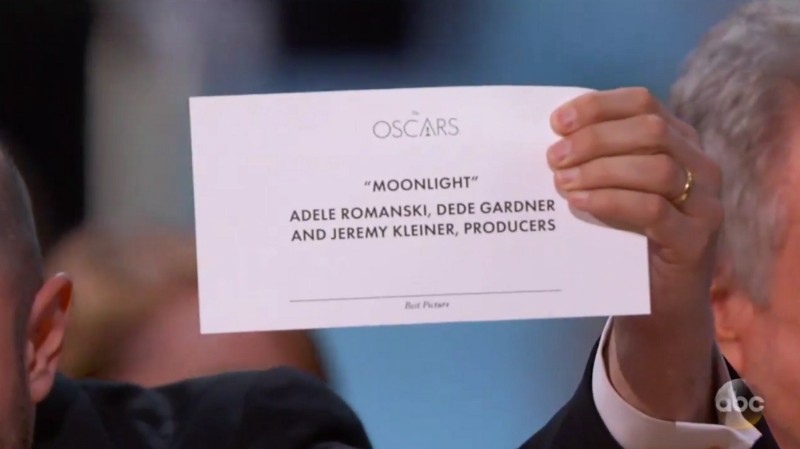
First, it’s legible, you can tell all the letters apart. Second, it’s somewhat readable, but the visual weight of “Moonlight” and the producers are equal and blend together. Lastly, even though it is just a winner’s card, it’s not visually appealing. I think it’s fair to say it’s objectively bland.
Based on that card design, I’ve reconstructed the card Warren and Faye would’ve seen, the one they received:

That’s horrible typography. I will emphasize horrible again. Horrible. Or to be nicer — not good. Look at it again. Of course, anyone could’ve made the same honest error!
The words “Best Actress” is on there — at the very bottom — in small print!
You are on television with millions of people around the world watching. You are a little nervous, and you have to read a card. You will most likely read it from top to bottom (visual hierarchy) without questioning whether the card is right. That look on Warren’s face was, “This says ‘Emma Stone’ on it.” Faye must’ve skipped that part and was caught up in the excitement and just blurted out, “La La Land.”
I don’t blame Faye or Warren for this. This was the fault of two entities: whoever was in charge of the design of the winning card (Was it really a design? C’mon), and the unfortunate person who handed them the wrong envelope.
A clearly designed card and envelope (don’t even get me started on that gold on red envelope) would've prevented this.
Here are the main three things wrong with the winner cards in general:
- We all know this is the Oscars, but the logo doesn’t need to be at the top of the card.
- The category, “Actress,” is on the bottom, in small print.
- The winner’s name, the main thing that should be read, is the same size as the second line and given equal weight.
Now, let’s imagine an alternate timeline where the presenters were given this modified version of the wrong card, using the same elements of the original card:
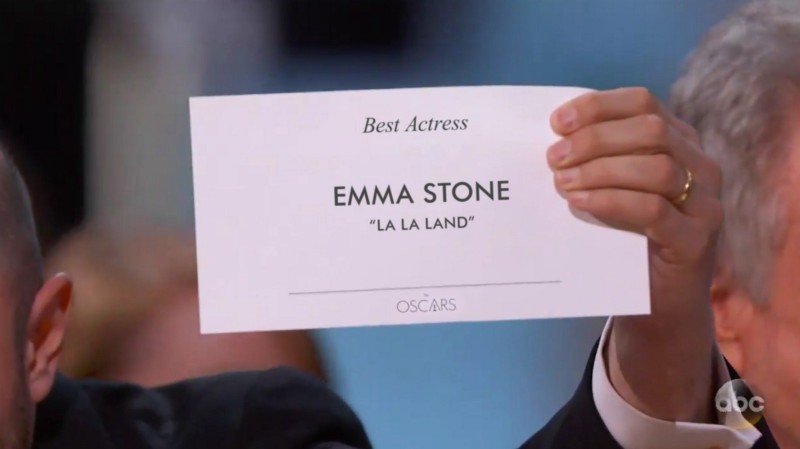
It may not seem like much to a regular person, but changing the sizing, positioning, and weight of the text makes a big difference. A big enough difference that this embarrassing mistake could’ve been prevented.
Let’s analyze the differences between the original card and my modified card with a side-by-side comparison of subtle, yet important changes.
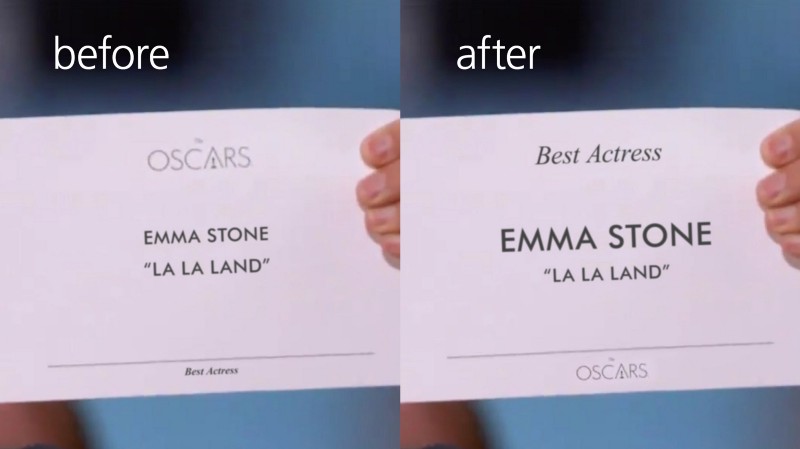
Here’s what should’ve been changed based on the three critiques I just made:
- The logo doesn’t need to be at the top. Everyone knows it’s the Oscars. We move the Oscar logo to the bottom where it’s least important in this context.
- The award category, “Best Actress,” is moved to the top so that it’s the first thing anyone sees and reads. There is no confusion what the category is because it’s clearly stated first.
- Emma Stone’s name is bigger than the title, “La La Land,” because she is the winner of this category. The winner should be the most emphasized thing on the card with all other information, like the film’s title, in a smaller or a less thick font (I understand that the text can only be so big so as to have a consistent look for all the cards, while accommodating longer names).
That’s it. That’s all the designer needed to do. Those three things. I guess hiring a card designer wasn’t in the budget this year.
With a modified card, even if the presenters had gotten the wrong one, none of this would’ve happened because the presenters would’ve looked at it and one of two things would’ve happened: their eyes would’ve read “Best Actress,” or, “Emma Stone.” Reading either of those would indicate that this wasn’t the card for Best Picture, and they would’ve asked Jimmy Kimmel or a producer to the stage to get it corrected.
The card needed to be written and designed in a way that makes it clear to the reader only the essential information.
As a creator, the importance of typography is an absolute skill to know, and people — not just designers, should consider learning it. Typography can be immensely helpful when writing a resume that’s well-structured, creating a report that looks exciting, designing a website with an intuitive hierarchy — and definitely for designing award show winner cards.
And lastly, to the Academy of Motion Picture Arts and Sciences, I would like to submit my design template for the 90th Academy Awards winner’s card (my commission fee is more than reasonable, and this is only one of many ideas). The card is clean and easy to read for any presenter, with only relevant information. Even the words, “The Oscars,” don’t need to be on there (fewer words to read). The statue graphic works fine.
And a big congratulations to Moonlight for winning Best Picture!
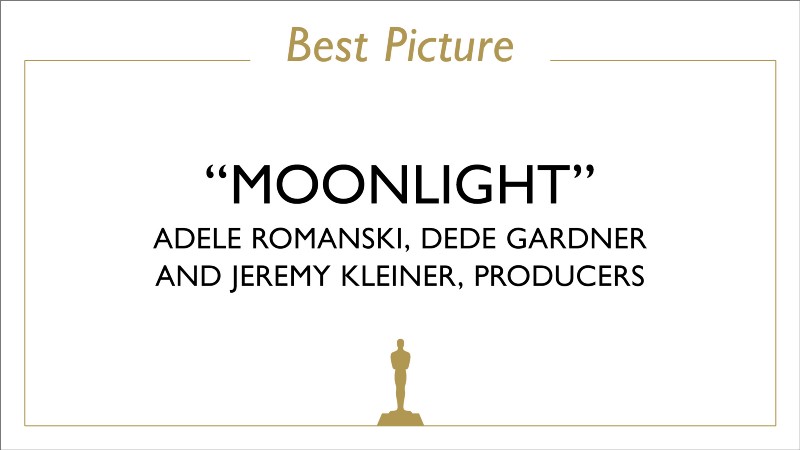
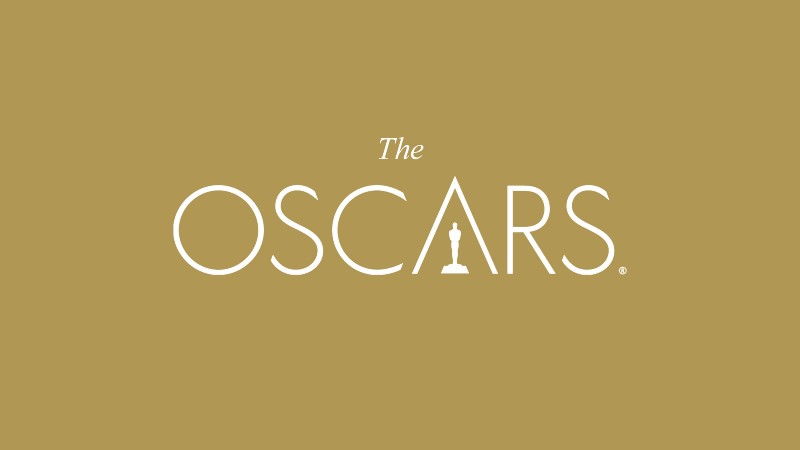
Show your support by clapping this article, tweeting it, sharing it, and follow me to discover new things.
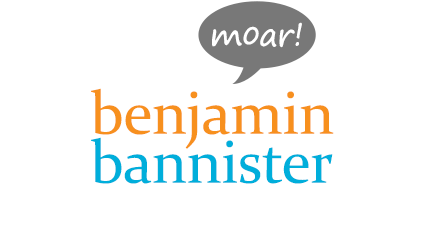
Also by benjamin bannister:
